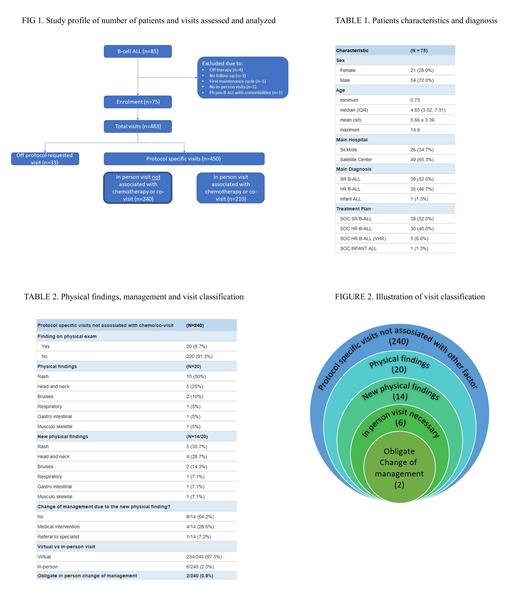Abstract

Background
Acute Lymphoblastic Leukemia (ALL) is the most common cancer seen in the pediatric age group. The treatment consists of an initial intensive phase of chemotherapy followed by a prolonged period of maintenance chemotherapy intended to reduce the risk of relapse. Children are commonly seen in clinic every 4-6 weeks for bloodwork and physical examination during the maintenance phase. The COVID-19 pandemic has prompted consideration of alternative means of providing medical care. The objective of this study was to determine the proportion of in-person clinic visits during ALL maintenance therapy for which the outcome of the physical examination resulted in a change of patient management.
Methods
A retrospective chart review of children diagnosed with precursor-B ALL between January 2017 and December 2018, and who were in maintenance therapy between September 2019 and February 2020, was conducted. All routine maintenance visits were reviewed to identify new physical examination findings and patient outcomes and classified as either "could be managed virtually" or "essential in-person visit". For the latter, a second classification was conducted to distinguish between visits necessitating a change of management versus not.
Results
Eighty-five children were diagnosed with precursor B ALL and continued to maintenance treatment during the study period. 10 children were excluded as not meeting the inclusion criteria or not evaluable. Of the remaining 75 children, 54 were male (72%) and 21 female (28%). The median age at diagnosis was 4.83 years (0.73 - 14.8 years). 39 patients (52%) had standard risk ALL, 35 patients (46.7%) had high risk ALL and one patient had Infant ALL (1.3%) A total of 240 routine maintenance visits were included in the final analysis. An abnormal physical exam finding was noted in 20 visits (8.3%) and of these, new findings were noted in 14 (5.8%). 6 visits were classified as essential in-person visits (2 for new bruising, 1 for new limp, 1 for new lymphadenopathy, 1 for acute otitis media, and 1 for new wheezing). Among the 14 visits with new exam findings, only 5 had an impact on patient management and of these, only 2 (0.8%) were classified as obligate in-person visit for requiring immediate management (acute otitis media and wheezing).
Conclusion
Our results demonstrate that most in-person visits can be provided as virtual visits without affecting patient outcomes. The results of this study provide the foundation for a prospective study that will evaluate the benefits, risks and families' preferences associated with virtual visits and delineate the optimal frequency and timing of in-person clinic visits during ALL maintenance therapy.
No relevant conflicts of interest to declare.
Author notes
 This icon denotes a clinically relevant abstract
This icon denotes a clinically relevant abstract


This feature is available to Subscribers Only
Sign In or Create an Account Close Modal